Ausstellung vom 25. Juni bis 27. August 2023 – Eröffnung am Samstag, 24. Juni 2023
Mit CENTURY. idee bauhaus zeigt die Stiftung Konzeptuelle Kunst ein herausragendes, 106-teiliges Konvolut der Sammlung Schroth.
Die Kuratorin Christiane Bail, und der Ausstellungsmacher Matthias Seidel von der Berliner Programmgalerie drj art projects haben »CENTURY. idee bauhaus« als Projekt zum Bauhaus-Jubiläumsjahr 2019 konzipiert und realisiert. Gemeinsam mit Museumsdirektorinnen Simone Schimpf und Sibylle Hoiman, Kunstwissenschaftler Frederik Schikowski sowie Architekt und Kunstsammler Frank F. Drewes wurden der Vielzahl internationaler Künstlerinnen und Künstler ausgewählt und eingeladen, ihre persönlichen Reflexionen über das Bauhaus in Form eines DIN-A4-Blattes einzureichen. Diese individuellen Beiträge beleuchten ein breites Spektrum künstlerischer Ansätze und Haltungen, das sowohl persönliche Nähe als auch kritische Distanz zum Thema umfasst.
Zum Auftakt der Europäischen Kulturhauptstadt 2023 wurde CENTURY. idee bauhaus im Rahmen der Kooperation »Kultur.Kontakt.Konkret« in Veszprém präsentiert und um sechs ausgewählte ungarische Positionen erweitert. Wie die ursprünglichen 100 Werke sind auch diese nach den festgelegten Parametern entworfen und ausgeführt.
Frisch aus Ungarn zurückgekehrt, wird dieses nun 100+6 Einzelwerke umfassende Konvolut im Kabinett des Museum Wilhelm Morgner parallel zur Ausstellung von Werken der ungarischen Sammlung Vass, die in Umgang und Raum Schroth zu sehen ist, präsentiert.




















































